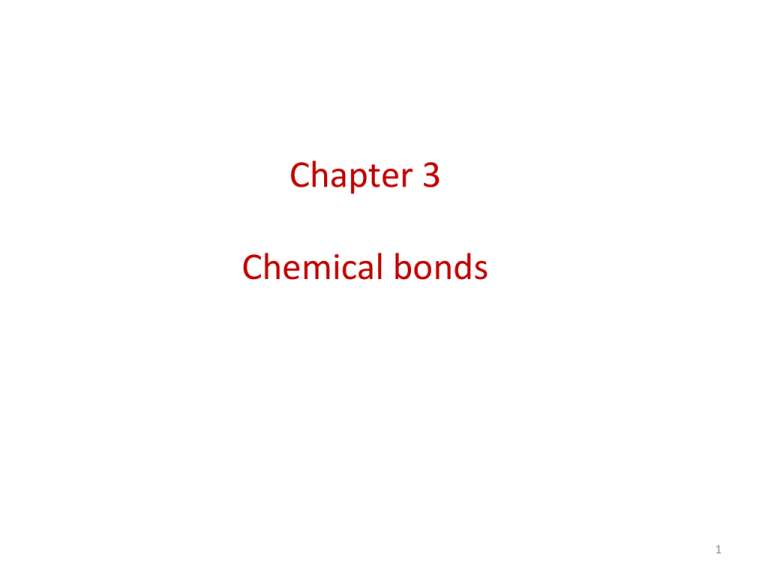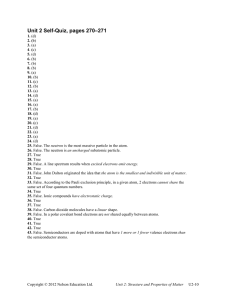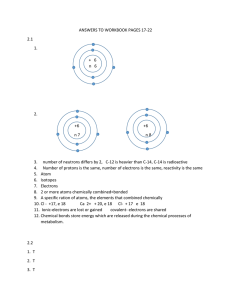Chapter 3 Chemical bonds 1
advertisement

Chapter 3 Chemical bonds 1 Bonds between Atoms Each atoms is unique due to their differing; • Sizes; • Electron Affinities; • Ionization Energies. As the gravitational force varies with size and distance, atoms, like planets, have similar unique and variable inherent strengths and forces that influence other atoms. Atoms minimize these imbalances by forming bonds. 2 Bonds between Atoms Atoms strive to fill their outer shells with electrons just like a noble gas does. In a generalized-way atoms can achieve satisfaction by forming two types of bonds: ionic and covalent Ionic is gaining & losing electrons Covalent is sharing electrons The resulting bond is lower in energy than the separate atoms. 3 If electrons transfer from one or more atoms, the entire compound is held together by electrostatic attractions between all the ions. This attraction is called an ionic bond. Note: the energy is lower when Na+ and Cl- ions bind than separated sodium and chlorine atoms. The new partnership is lower in energy than the separate Atoms. 4 Binary ionic compound form between s-block metal, and a nonmetallic element. Cation and anions stack themselves into alternating sodium ions with chloride ions, oppositely charged ions are lined up in all three dimensions. An example of an ionic crystalline solid. 5 Metals S-block metals form cations, by losing electrons to their noble-gas core or octet of electrons. Al forms the Al3+ ending with [Ne] electron configuration by the loss of it’s s and p electrons noble-gas core 6 Ga3+ 4p block d electrons remain Metallic elements, in Period 4 and later, lose their s- and pelectrons. Ga3+, [Ar]3d10 The d electrons of the p-block atoms are gripped tightly by the nucleus and cannot be lost. 7 Write the electron configurations of In+ and In3+ Remove electrons from the valence-shell p-orbitals first, then from the s-orbitals Determine the configuration of the neutral atom. [Kr]4d105s25p1 Remove the outermost electron. In+ [Kr]4d105s2 Remove the next two outermost electron. In3+ [Kr]4d10 8 Nonmetals rarely lose electrons because their ionization and electron affinity energies are too high. Instead, nonmetal atom acquire electrons to fill their outer shell N [He]2s22p3 plus 3 e- to N3-[Ne] 9 G. N. Lewis A single dot represents a valence electron (outer most electrons in the last shell) in the atom. A pair of dots represents two paired electrons sharing an orbital. N Each symbol is thought of as having four sides, W E a north, south, east, and west position, where valance electrons are shown as dots S 10 X An ionic formula starts by removing valance electrons from the metal and transferring them to the nonmetal atom to complete its valence shell. The calcium atom loses its two valence electrons. Each chlorine atom has one vacancy electron so it forms one bond. 11 Two chloride ions (Cl-) balances the charge for each calcium ion (Ca2+) resulting in the formula CaCI2; the overall charges is zero. There are no CaCl2 molecules, only crystals of threedimensional arrays of CaCl2 ions held by the vast array of opposite charges spread throughout the crystal-hence CaCl2 is called a formal unit. 12 Crystal formation starts when large numbers of oppositely charged ions, mad-rush together, releasing large amounts of energy. 13 A crystal of sodium chloride has lower energy than separated sodium and chlorine atoms. Formation of the solid takes place in three steps: Na Cl 1. Sodium atoms release electrons; 2. These electrons attach to chlorine atoms; NaCl 3. Newly formed cations and anions clump together as a crystal. 14 Crystal Lattice is stability gained when ions form ionic solid Bond disassociation of Cl2(g) to 2 Cl(g) = +122 kJ Ionization of Na (g) to Na+(g) = +494 kJ Sublimation of Na (s) to Na (g) = +108 kJ Heat of Formation of ionic solid from its elements = -411 kJ 2 Cl (g) + 411 + 108 + 494 - 349 +494 -349 -787+=122 -642 kJ = -787 kJ Electron affinity Cl (g) to Cl- (g) = -349 kJ Na+ (g) + Cl- (g) Na+ (g) Na (g) Na(s) + Cl2(g) A solid composing of Na+ and Cl- ions has a lower energy than neutral Na and CI atoms by -642 kJ Na+Cl- (s) Crystal Lattice energy for Na+ + Cl- (g) to the ionic +Cl- (s) solid Na Crystal Lattice = -787 kJ Energy? See also Example 7.13 15 Lattice energy is a "global" characteristic of the entire crystal, a net lowering of energy in the entire crystal (once the cations and anions clump together as a crystal). A high lattice energy value indicates a stronger ion pair which produces a more tightly bonded solid. Coulomb's Potential Energy measure the strength between individual ion pairs 16 The strong attraction (Coulomb's Potential Energy) between oppositely charged ions accounts for the typical properties of ionic solids: • high melting points and • brittleness. 17 Covalent Bonds form between two nonmetals that do not form into ions. The nature of nonmetal bonds puzzled scientists until 1916, when G.N. Lewis published his explanation. A brilliant insight, before anyone knew anything about quantum mechanics. No Columbic interactions Shared electron pair 18 Covalent bonds form by atoms sharing electrons until they reach a noble-gas configuration. Lewis called this principle the octet rule, reaching a noblegas configuration Ionic bonds form when one element loses electrons and the other atom gains electrons, until both atoms reach a noble-gas configuration. 19 Lewis: Share to an Octet A fluorine atom can achieve an octet by accepting a share in an electron from another fluorine atom. The octet (or duplet) shows lines (bonding pairs) and dots (lone pairs). 20 Rules to Write Dot Structures 1. Write a skeleton molecule with the lone atom in the middle (Hydrogen can never be in the middle). 2. Find the number of electrons needed (N) (8 x number of atoms, 2 x number of H atoms) 1. Find the number of electrons you have (valence e-'s) (H) 2. Subtract to find the number of bonding electrons (N-H=B) 3. Subtract again to find the number of non-bonding electrons (H-B=NB) 4. Insert minimum number of bonding electrons in the skeleton between atoms only. Add more bonding if needed until you have B bonding electrons. 5. Insert needed non-bonding electrons around (not between) atoms so that all atoms have 8 electrons around them. The total should be the same as NB in 5 above. 21 Water H2O 1. S 2. N 3. H 4. B 5. NB H O H 2 × 2 = 4 for Hydrogen 1 × 8 = 8 for Oxygen 4+8 = 12 needed electrons 12 N 2 × 1 = 2 for Hydrogen 1 × 6 = 6 for Oxygen You have 8 available electrons 12 - 8 = 4 bonding electrons 8 - 4 = 4 non-bonding electrons 6. .. H:O:H .. .. H–O .. – H - 8H - 4B 4 NB H:O:H Single bond 22 Carbon dioxide CO2 1. S O C O 2. N 1 x 8 = 8 for Carbon 2 x 8 = 16 for Oxygen 8+16=24 needed electrons 3. H 1 x 4 = 4 for Carbon 2 x 6 = 12 for Oxygen You have 16 available electrons 4. B 5. NB 6. 24 - 16 = 8 bonding electrons 16 – 8 = 8 non-bonding electrons .. .. ●● ●● O::C::O .. .. O .. = C = O .. 24 N - 16 H - 8B 8 NB O::C::O Double bond 23 Acetylene 1. S 2. N 3. H 4. B 5. NB C2H2 H C C H 2 × 8 = 16 for Carbon 2 × 2 = 4 for Hydrogen 16+4 = 20 needed electrons 20 N 2 × 4 = 8 for Carbon 2 × 1 = 2 for Hydrogen You have 10 available electrons - 10 H 20 - 10 = 10 bonding electrons 10 - 10 = 0 non-bonding electrons - 10 B 0 NB 6. H C C H H C::C H H C C H Triple bond 24 Practice Write the Lewis structure for the: NH4+ CN- 25 Helpful reminders (3) Remember simple Lewis Dot diagrams 1 bond, 4 bonds, 2 bonds to complete their octet C2H4 Molecules have symmetry 26 Helpful reminders Read the formula for order of atom attachment CH3COOH acetic acid Carbons makes 4 bonds and oxygen makes 2 bonds to complete the octet. 27 Resonance Structures Delocalized electrons hop from one atom to another; no discretion as long as it’s the same atom pair. Resonance Structures Resonance arrows 28 K𝖾kulé aromatic structures Final, “blended” structure for Benzene 29 Formal Charge 𝐹𝑜𝑟𝑚𝑎𝑙 𝐶ℎ𝑎𝑟𝑔𝑒 = 𝑉 − 1 𝐿+ 𝐵 2 O 6 - (4 + ½ 4) = 0 Cl 7 - (6 + ½ 2) = 0 C 4 - (0 + ½ 8) = 0 The sum of formal charges is equal to the overall charge of the molecule or ion; electrically neutral molecule, have a formal charge of zero. 30 𝐹𝑜𝑟𝑚𝑎𝑙 𝐶ℎ𝑎𝑟𝑔𝑒 = 𝑉 − 1 𝐿+ 𝐵 2 Formal charges can predict the most favorable Lewis structure: NNO CNS- The structure with the lowest formal charges on each atom is the most plausible (lowest energy) structure. 31 Exceptions to the Octet Rule Radicals are something you cannot isolate, are very unstable and are highly reactive. 32 Gingko biloba like other green leafy eatable plants. Vitamins A, C and E are antioxidant enzymes, a group of compounds called coenzyme Q. Antioxidants are free-radical 33 traps. Exceptions to the Octet Rule Carbon, nitrogen, oxygen, and fluorine obey the octet rule rigorously. Period 3 and subsequent periods can accommodate more than eight electrons in its valence shell, up to 12 electrons. PCl3(l) + Cl2(g) PCl5(s) PCl5 Dissociation of PCl5 34 Exceptions to the Octet Rule Determine the most stable resonance structure P 5-(0+½10)= 0 O 6-(4+½4)= 0 O 6-(6+½1)= -1 P 5-(0+½12)= -1 P 5-(0+½8)= +1 O 6-(4+½4)= 0 O 6-(6+½1)= -1 O 6-(6+½1)= -1 35 Exceptions to the Octet Rule ClO4- (VE 7+24+1=32) O O - 12 electrons on the central atom, fewest charges O Cl O 0 - +3 O - O - O +2 Cl - O O - O - - Cl O + O O - - O Cl O O Cl: 7-4=+3 Cl: 7-5=+2 Cl: 7-6=+1 Cl: 7-7=0 O: 6-7= (-1)4 O: 6-6=0 O: 6-6=0 O:6-6=0 net O: 6-7= (-1)3 O: 6-7= (-1)2 O: 6-7= -1 net: net net -1 -1 All atoms have a charge High charge for Cl -1 -1 Central atom has to many electrons 36 Self Test Which is the more stable? F B 0 +1 0 -1 7-(6+½2)= 0 3-(0+½6)= 0 F B 7-(4+½4)= +1 3-(0+½8)= -1 37 Electronegativity values by Linus Pauling. Increasing EA & IE Increasing EA & IE If an atom gives up an electron reluctantly it has high ionization energy and if the electrons attaches favorable it 38 has high electron affinity. Covalent bonds Nonpolar covalent bond: electrons are shared equally. Polar covalent bond: electrons are shared unequally. δ+ δ- H Cl Dipole 39 Electronegativity & bonds Electronegativity Difference Between Bonded Atoms Type of Bond Less than 0.5 Nonpolar Covalent 0.5 to 1.9 Polar Covalent Greater than 1.9 Ionic H H 2.1 – 2.1 = 0 Nonpolar covalent N H 3.0 – 2.1 = 0.9 polar covalent Na F 4.0 – 0.9 = 3.1 Ionic 40 Electronegativity difference Li-F |1.0 – 4.0|= 3.0 H-Cl |2.2 - 3.2|= 1.0 Ionic Non-polar Polar Covalent Covalent 41 Al3+ BrIncreasing polarizing power Li+ Be2+ Na+ Mg2+ Charge ↑ & Size ↓ Polarization by small, highly charged cations of larger, nearby anions. 42 Notice that a single bond is weaker than a triple bond. 43 Electrons in double and triple bonds are not as concentrated between two atoms as they are in a single bonds. 3 C-C 2 C-C C-C 44 Strength↓ as Size ↑ Bond Strength kJ Atomic Radii 45 Strength↓ as Size ↑ Atomic Radii 46 Bond Lengths ↑ as size ↑ Atomic Radii 47 Strong bonds typically are stiffer than weak bonds. Triple bonds shorter and stronger Molecules absorb infrared radiation (1000 nm or about 3 × 1014 Hz) and become vibrationally excited. We treat the bonds like springs. IR radiation 2 basic ways atoms move: stretching and bending Stretching symmetric asymmetric Bending scissoring rocking wagging twisting 49 C=C CC Stronger and Shorter C-C Stronger and Shorter Bond strength determines the amount of IR needed to move the bonds. 50 Infrared spectroscopy of an amino acid Stronger and Shorter 51





